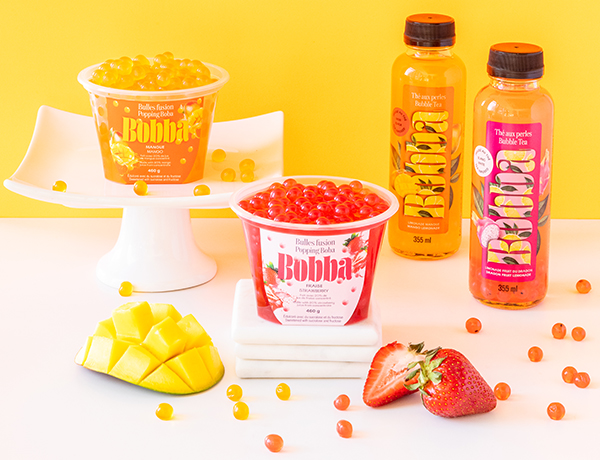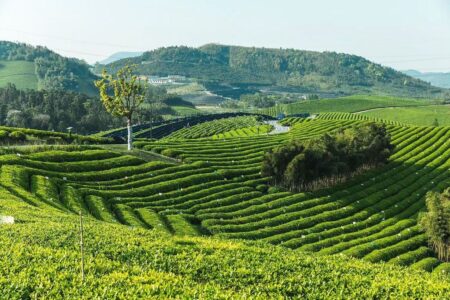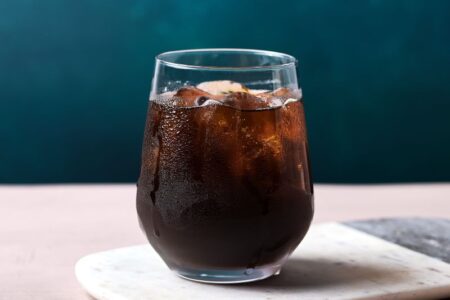Bubbles on the Rise

Bobba’s RTD bottled bubble tea and boba pearls. Image credit: Bobba
Bubble tea was once a trend or fad that would come and go every few years in select countries and cities, at least since the start of the new millennium. However, now being embraced by younger millennials and Gen Z, bubble tea has been growing in popularity globally and moved past ‘trendy’ to a growing tea category given its social media-posting appeal, its many flavours and customisation options. By Kathryn Brand.
While to many, bubble or boba tea might seem like a new fad that has surfaced over the last couple of years, it is by no means a recent invention. Bubble tea is typically a milk- or juice-based tea drink containing soft and chewy tapioca pearls, or boba, made with flour from cassava. It originated in Taiwan in the early 1980s, from there it spread across East and Southeast Asia (in particular Singapore, Japan, Hong Kong, Vietnam, and mainland China), and was brought to the United States in the 90s to Asian American diasporic communities such as in California, the East Coast and West Coast and the Southeast.
There are myriad variations of the beverage, offering different tea varieties such as black, green or oolong as the base, fresh milk, powdered milk or juice options, as well as the boba themselves, which are sometimes added to or substituted with grass jellies, or juice filled boba known as popping boba. It is a unique product in that it is simultaneously a drink and a snack, with the flavoured tea providing the beverage, and the carbohydrate and fibre heavy boba offering a filling accompaniment.
It emerged in the mainstream in recent years and now has a market value that, according to global market research firm, Future Market Insights (FMI), is currently valued at USD $2.5 billion in 2022, and is expected to reach $5.82 billion by 2032, performing at an 8.8 percent growth rate. This ever growing success can be attributed to several factors. “Now that Asian American communities have a saturation of boba tea shops, many franchises and small business owners thought it would be best to introduce the treat to other communities, communities that have never heard of bubble tea,” explained Christine Trinidad, CMO of Milk+T, a company that began with its self-serve boba truck in 2015, and now has brick and mortar locations in Los Angeles, California and Beaverton, Oregon.
From there, it has been adopted by the Gen Z and millennial generations, to whom “the boba tea shop is in the position that the soda shop was in the 1950s,” according to Jason Walker, marketing director, Firsd Tea, which has recently expanded into the wholesale bubble tea ingredients sector. “Whenever you go into a bubble tea shop, the place is full of young people. Young parents bring their children as a fun and sweet treat. Young couples and groups of teens hang out and chat over bubble tea,” observed Walker.
Since the beverage is so popular with a younger audience, social media has inevitably played a key role. Through connecting people across the world, it allows trends to cross countries and cultures, and bubble tea appeals to this medium due to its highly visual attributes. “For the local boba tea shop, social media is a powerful force for showcasing the colourful and attractive drinks they create. Think of the brown sugar milk tea (sometimes called tiger milk tea) – this is a drink that was made to be shared on social media – once you see the rich milk caramel colour of the drink with brown sugar tiger stripes streaming down the cup – you are hooked!” said Walker. The beverage lends itself to artistic photos by food bloggers or Instagrammers on social media, broadening its audience and its cult following.
There are a few giant boba shop chains, but predominantly they are independents, “that mom or pop just started because they love the product,” said David Fan, co-founder and CEO of US Boba Company, which supplies a few hundred boba stores with tapioca pearls it makes in the US, as well as to its partner retail company, Boba Guys. “So, they come to the table with more ideas. That’s what I think is another driving force behind boba tea; it’s not major corporations, it is small business owners,” continued Fan. This gives more opportunities for creativity, new flavours and exciting visuals that attract the trend-seeking Gen Zs and millennials.
Boba shops generally also offer extensive options for customisation. Each consumer can not only decide their tea base, milk or juice, boba type and amount, but there are variable sweetness and ice levels, as well as the options for it to be served hot, and with toppings such as whipped cream. Its customers have been cultured by Starbucks, Fan noted; people like to be able to create their order specific to them, so they feel the drink is their own, as well as offering the opportunity to try a new combination and order every time you go.
Although, he argues that there has to be a balance, with recommended or shop specialties on offer, too. “This streamlines operations for the store for expansion and also standardisation of a drink, because sometimes with a customisation you choose well, sometimes you don’t,” commented Fan. However, the sweetness level remains a popular customisation option, especially with the health conscious.
Adapting to Changing Tastes
As well as reduced sugar options, the base of tea, particularly green tea whose health benefits have been lauded for centuries, has added attraction for functional beverage seekers. What’s more, it is readily made vegan, with dairy-free options with juice or plant-based milks. While boba tea is traditionally made with fresh dairy milk or milk powder, vegan formats are a way for the beverage to adapt within the American and Western culture, said Trinidad.
The health and sustainability credentials of the drink was something that was important to Bobba when developing its products. Bobba offers ready-to-drink (RTD) bubble teas across Canada, having also recently opened markets in France and the US. All its drinks are juice based and vegan, with only 12 or 13g of sugar per bottle, compared to boba store offerings that can reach 100g, revealed Sebastien Fiset, president of Bobba. Instead, it sweetens its drinks with oligofructose and very pure stevia. “It was really important for us, and I think it was a good move because they have been a huge success,” commented Fiset. Bobba had to develop its own kind of boba to include in its drinks, as traditional tapioca would lose all its integrity submerged in a beverage for any great length of time, but this is something that the company believes sets it apart, as its boba is flavoured to match the drink it is in, and they are all popping boba, therefore they are filled with real fruit juice syrups to complement the flavours.

boba tea offering from Milk+T,
served in one of its glass jars.
Image credit: Milk+T
Bobba also sells all its drinks in glass bottles, instead of plastic. Bubble tea is traditionally sold from boba shops in clear plastic cups, with a film lid and wide plastic straw, which is competing with the consumer’s growing intolerance for single-use plastics. While glass is expensive, Bobba is committed to sticking with this format over the cheaper and lighter plastic packaging alternatives. “That’s why we do not offer straws with our products. We don’t want to be involved with [straws] because [they are] not very good for the environment,” said Fiset.
Milk+T follows a similar mantra, having offered sustainable alternatives ever since opening its doors in 2015. “We offer glass jars with every drink to help lower the use of single-use plastics,” explained Trinidad. It is something Firsd Tea and US Boba Co have been concerned about and are currently also exploring, with Firsd Tea looking into incentivising consumers to use their own metal or reusable straws, and US Boba Co. developing its own paper cups and compostable straws without any PE coating.
“I think it’s a worldwide issue that we have to face the fact that these disposables need to go on a course of slowly diminishing,” said Fan. The challenge with switching away from plastics in the bubble tea industry is that a lot of the drink’s appeal is its visuals and the layers and colours visible through the clear cup or bottle. “We will absolutely lose a lot of remarketing effect, as people sharing and resharing your posts is very important.” However, he believes the visual appeal lost from transitioning away from the clear cup formats, will be replaced by the appeal of the product being sustainable. “What kind of posts are most shared right now? It is the organic ones by the consumer,” Fan pointed out, and fortunately, sustainability is trendy right now, so the switch away from plastics for bubble tea may not negatively impact the market after all, it remains to be seen.

Tapioca pearls being added to
make a boba tea.
Image credit: US Boba
Company
As boba shops spread and RTD formats surface, companies are having to compete with one another to be increasingly creative, whether that be with their flavours, toppings, packaging, or sustainability credentials, creating a dynamic market that FMI predicts will continue to grow.
- Kathryn Brand, associate editor, joined Bell Publishing at the beginning of 2022 after graduating from the University of East Anglia with a degree in English Literature and Creative Writing. She may be reached at: [email protected].



